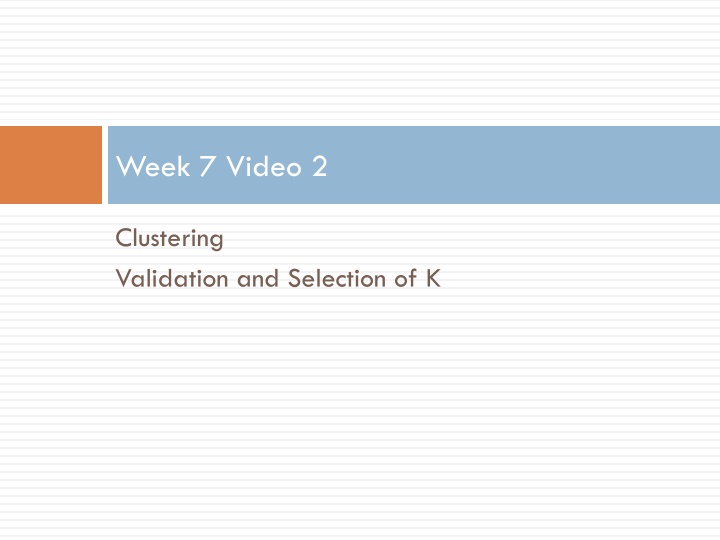
Clustering Validation and Selection of K for Better Results
Discover how to choose the optimal value for K in clustering algorithms, even after 17 randomized restarts. Learn about distortion, distance calculations, and the impact of cluster size on results.
Download Presentation

Please find below an Image/Link to download the presentation.
The content on the website is provided AS IS for your information and personal use only. It may not be sold, licensed, or shared on other websites without obtaining consent from the author. If you encounter any issues during the download, it is possible that the publisher has removed the file from their server.
You are allowed to download the files provided on this website for personal or commercial use, subject to the condition that they are used lawfully. All files are the property of their respective owners.
The content on the website is provided AS IS for your information and personal use only. It may not be sold, licensed, or shared on other websites without obtaining consent from the author.
E N D
Presentation Transcript
Week 7 Video 2 Clustering Validation and Selection of K
How do we choose? A value for k Which set of clusters to use, after 17 randomized restarts
First Let s take the case where we have 17 randomized restarts, each involving the same number of clusters
Distortion (Also called Mean Squared Deviation) Take each point P Find the centroid of P s cluster C Find the distance D from C to P Square D to get D Sum all D to get Distortion
Distance Usually Euclidean distance Distance from A to B in two dimensions (Ax-Bx)2+(Ay-By)2
Distance Euclidean distance can be computed for an arbitrary number of dimensions (Ai-Bi)2
Distortion Works for choosing between randomized restarts Does not work for choosing cluster size
Why not? More clusters almost always leads to smaller Distortion Distance to nearest cluster center should almost always be smaller with more clusters It only isn t when you have bad luck in your randomization
Cross-validation cant solve this problem A different problem than prediction modeling You re not trying to predict specific values You re determining whether any center is close to a given point More clusters cover the space more thoroughly So Distortion will often be smaller with more clusters, even if you cross-validate
An Example 14 centers, ill-chosen (you might get this by conducting cross-validation with too many centers) 2 centers, well-chosen (you might get this by conducting cross-validation with not enough centers)
+3 time 0 -3 0 1 pknow
+3 time 0 -3 0 1 pknow
An Example The ill-chosen 14 centers will achieve a better Distortion than the well-chosen 2 centers
Solution Penalize models with more clusters, according to how much extra fit would be expected from the additional clusters You can use the Bayesian Information Criterion or Akaike Information Criterion from week 2 Not just the same as cross-validation for this problem!
Using an Information Criterion Assess how much fit would be spuriously expected from a random N centroids (without allowing the centroids to move) Assess how much fit you actually had Find the difference
So how many clusters? Try several values of k Find best-fitting set of clusters for each value of k Choose k with best value of BiC (or AIC)
Silhouette Analysis (Rousseeuw, 1987; Kaufman & Rousseeuw, 1990) An increasingly popular method for determining how many clusters to use
Silhouette Analysis Silhouette plot shows how close each point in a cluster is to points in adjacent clusters Silhouette values scaled from -1 to 1 Close to +1: Data point is far from adjacent clusters Close to 0: Data point is at boundary between clusters Close to -1: Data point is closer to other cluster than its own cluster
Silhouette Formula For each data point i A(i) = average distance of i from all other data points in same cluster C C* = cluster with lowest average distance of i from all other data points in cluster c* B(i) = average dissimilarity of i from all other data points in cluster C* ? ? ?(?) max{? ? ,?(?) ? ? =
Example from http://scikit-learn.org/ stable/auto_examples/cluster/ plot_kmeans_silhouette_analysis.html
So in this example 2 and 4 clusters are reasonable choices 3, 5, and 6 clusters are not good choices
Eigengap In spectral clustering there is also the option of choosing the number of clusters that maximizes the eigengap (difference between consecutive eigenvalues)
Alternate approach One question you should ask when choosing the number of clusters is why am I conducting cluster analysis? If your goal is to just discover qualitatively interesting patterns in the data, you may want to do something simpler than using an information criterion Add clusters until you don t get interesting new clusters anymore
Next lecture Clustering Advanced clustering algorithms
